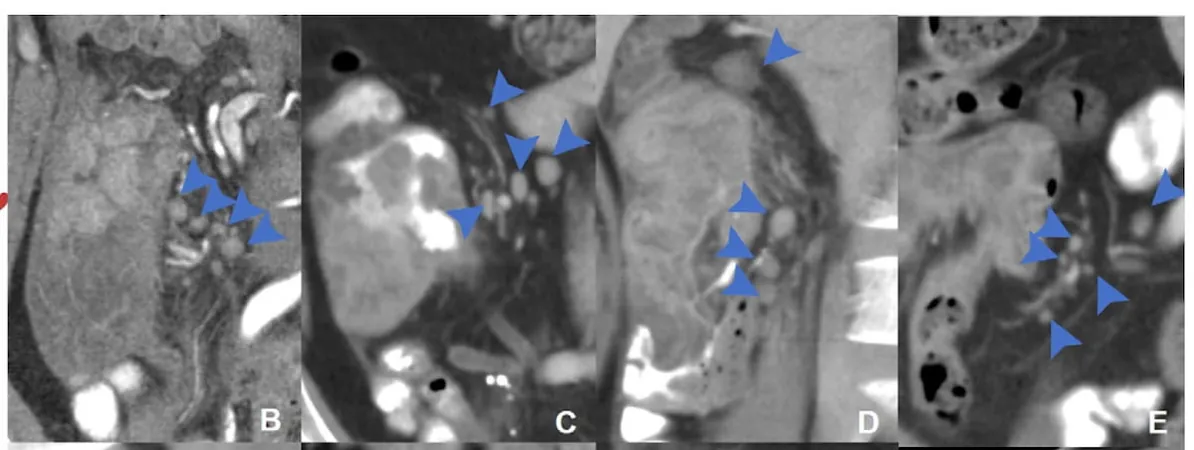
Revolutionizing Colon Cancer Staging: The Game-Changing Role of Lymph Node Distribution Patterns on CT Scans
2025-04-11
Author: Yu
In a groundbreaking new study, researchers have unveiled how analyzing lymph node distribution patterns via computed tomography (CT) scans could dramatically improve the detection of regional lymph node metastases in patients suffering from microsatellite instability-high (MSI-H) colon cancer.
Published in *Radiology*, the retrospective study evaluated 368 patients (average age 60) diagnosed with MSI-H colon cancer, aiming to showcase the power of distribution-based clinical lymph node staging (dCN). The findings promise to alter the landscape of cancer staging significantly.
The research’s test sample of 86 patients revealed that dCN achieved a striking 90% accuracy and 97% specificity in identifying metastatic lymph nodes, a stark contrast to the mere 46% accuracy and 26% specificity of traditional clinical lymph node staging (cN). This leap indicates that the dCN method is on track to redefine diagnostic protocols.
Among the data, one alarming revelation was that a jammed cluster distribution pattern posed a staggering 78.9 times higher risk for tumor metastasis, while a partial fusion pattern increased risk by 21.5 times. These alarming statistics paint a clearer picture for oncologists navigating the complexities of lymph node metastasis.
Dr. Zhen Guan, lead author and member of the Peking University Cancer Hospital and Institute, stated, "Our findings confirm that blurred margins, clustering, and fusion patterns in lymph nodes are critical indicators for diagnosing metastasis. This shifts our focus from individual lymph node characteristics to overall lymph node distributions, thereby enhancing diagnostic accuracy and consistency in staging processes."
3 Key Insights: Why This Study is a Game-Changer
1. **Stunning Accuracy**: The new dCN method dramatically outperforms existing cN methods in accuracy and specificity, representing a significant leap forward for colon cancer diagnosis.
2. **Predictive Patterns**: The study highlighted specific distribution patterns that can serve as early warning signs for lymph node metastasis, giving oncologists new tools to act decisively.
3. **Consistency and Reliability**: With dCN reducing the over-staging rate to just 2%—a significant drop from the 48.1% seen in cN staging—this approach could foster greater agreement among radiologists, addressing a long-standing issue of variability and ambiguity in cancer staging.
The researchers emphasize the need for a paradigm shift in approach, suggesting that future studies should prioritize the overall characteristics of lymph node clusters rather than focusing narrowly on individual nodes.
While promising, the study does have limitations, including the absence of certain patient data and the lack of comprehensive imaging methods like PET/CT. Nonetheless, the implications of these findings could reshape the future of colon cancer staging and improve patient outcomes.



 Brasil (PT)
Brasil (PT)
 Canada (EN)
Canada (EN)
 Chile (ES)
Chile (ES)
 Česko (CS)
Česko (CS)
 대한민국 (KO)
대한민국 (KO)
 España (ES)
España (ES)
 France (FR)
France (FR)
 Hong Kong (EN)
Hong Kong (EN)
 Italia (IT)
Italia (IT)
 日本 (JA)
日本 (JA)
 Magyarország (HU)
Magyarország (HU)
 Norge (NO)
Norge (NO)
 Polska (PL)
Polska (PL)
 Schweiz (DE)
Schweiz (DE)
 Singapore (EN)
Singapore (EN)
 Sverige (SV)
Sverige (SV)
 Suomi (FI)
Suomi (FI)
 Türkiye (TR)
Türkiye (TR)
 الإمارات العربية المتحدة (AR)
الإمارات العربية المتحدة (AR)